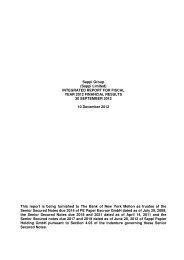2007 Annual Report - Sappi
2007 Annual Report - Sappi
2007 Annual Report - Sappi
Create successful ePaper yourself
Turn your PDF publications into a flip-book with our unique Google optimized e-Paper software.
2.3.13 Plantations<br />
Plantations are stated at fair value less estimated cost to sell at<br />
the harvesting stage. Fair value is determined using the present<br />
value of expected future cashflows for immature timber and the<br />
standing value method for mature timber. The age threshold<br />
used for quantifying immature timber is dependent on the<br />
rotation period of the specific timber genus which varies<br />
between eight to eighteen years. In the Southern African region<br />
softwood less than eight years and hardwood less than five<br />
years is classified as immature timber. All changes in fair value<br />
are recognised in the period in which they arise.<br />
The fair value of immature timber is the present value of the<br />
expected future cashflows taking into account, unadjusted<br />
current market prices, estimated projected growth over the<br />
rotation period for the existing immature timber volumes in<br />
metric tonne, cost of delivery and estimated maintenance costs<br />
up to the timber becoming. The discount rate used is the<br />
applicable pre-tax weighted average cost of capital of the<br />
business unit. The standing value for mature timber is based<br />
on unadjusted current market prices and estimated timber<br />
volumes in metric tonne less cost of delivery.<br />
Cost of delivery includes all costs associated with getting the<br />
harvested agricultural produce to the market, being harvesting,<br />
loading, transport and allocated fixed overheads.<br />
Trees are generally felled at the optimum age when ready for<br />
intended use. At the time the tree is felled it is taken out of<br />
plantations and accounted for under inventory and reported as<br />
depletion cost (felllings).<br />
Depletion costs include the fair value of timber felled, which is<br />
determined on the average method, plus amounts written off<br />
against standing timber to cover loss or damage caused by fire,<br />
disease and stunted growth. These costs are accounted for on<br />
a cost per metric tonne allocation method multiplied by<br />
unadjusted current market prices. Tons are calculated using the<br />
projected growth to rotation age and are extrapolated to current<br />
age on a straight line basis.<br />
<strong>Sappi</strong> directly manages plantations established on its own land<br />
that the company either owns or leases from a third party.<br />
Indirectly managed plantations represents plantations established<br />
on land held by independent commercial farmers where <strong>Sappi</strong><br />
provides technical advice on the growing and tendering of trees.<br />
The associated costs for managing the plantations are<br />
recognised as silviculture costs in cost of sales (see note 4.1).<br />
Land is accounted for under property, plant and equipment<br />
separately from the trees which are accounted for as plantations.<br />
2.3.14 Property, plant and equipment<br />
Property, plant and equipment represents all items and<br />
equipment that are held-for-use in the production or supply of<br />
goods or services, for rental to others, or for administrative<br />
purposes and are expected to be used during more than<br />
one period. Land, logging roads and related facilities used<br />
for and at our tree plantations is accounted separately from<br />
the plantations.<br />
Items of property, plant and equipment are stated at cost<br />
less accumulated depreciation and impairment losses. Cost<br />
includes the estimated cost of dismantling and removing the<br />
assets, where specifically required in terms of legislative<br />
requirements or a constructive obligation exists.<br />
Owner-occupied investment properties and properties in the<br />
course of construction are carried at cost, less any impairment<br />
loss where the recoverable amount of the asset is estimated to<br />
be lower than its carrying value. Cost includes professional fees<br />
and, for qualifying assets, borrowing costs capitalised in<br />
accordance with the group’s accounting policy. Depreciation<br />
commences, on the same basis as other property assets, when<br />
the assets are ready for their intended use. The group currently<br />
does not hold any investment properties.<br />
Subsequent expenditure is capitalised when it is measurable<br />
and will result in probable future economic benefits. Expenditure<br />
incurred to replace a component of an item of owner-occupied<br />
property or equipment is capitalised to the cost of the item of<br />
owner-occupied property and equipment and the part replaced<br />
is derecognised. All other expenditure is recognised in profit or<br />
loss as an expense when incurred.<br />
Depreciation is charged so as to write-off the depreciable<br />
amount of the assets, other than land, over their estimated<br />
useful lives to estimated residual values, using a method that<br />
reflects the pattern in which the asset’s future economic<br />
benefits are expected to be consumed by the entity.<br />
Where significant parts of an item have different useful lives to<br />
the item itself, these parts are depreciated over their estimated<br />
useful lives. The methods of depreciation, useful lives and<br />
residual values are reviewed annually.<br />
sappi limited | 07 | annual report 83
















